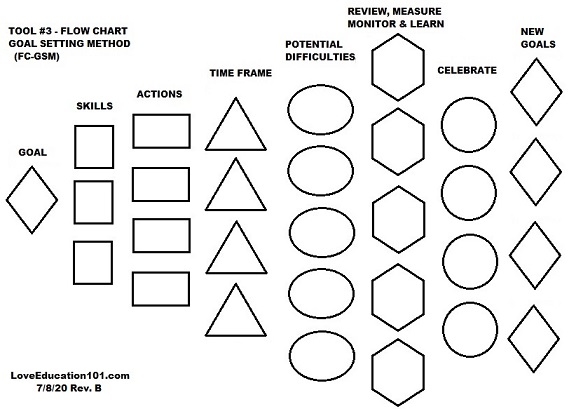

Love Ed 201

A SMART goal is a carefully planned, clear and trackable objective. It stands for Specific, Measurable, Achievable, Relevant and Time-based. They are well defined targets that you intend to accomplish over an established period of time.
The Benefits of Goal Setting include:
1) Direction. First and foremost, goals give you a direction and a destination.
2) Starts you on your journey.
3) Clear focus on what is important.
4) Decision making experience.
5) Provides control of your future.
6) Increases motivation.
7) Bestows a sense of personal satisfaction and self-esteem.
8) Gives you a sense of purpose in life.
9) Provides a reward for personal achievement.
10) Improves your relationship with yourself and others.
Your goals should also correlate to your Personal Mission and Vision statement, something that will be addressed here before July 15.
This tool is a forward looking process where you define the goals you want to achieve and then determine appropriate steps to reach those goals.
1. Write down all your goals and dreams.
2. Sort them into major and minor goals.
3. Which are Short term and long term.
4. Now determine which ones you want to focus on first, second and third. Choose one or two major and minor goals.
5. Use the SMART method when defining your top goals. Are they Specific, Measurable, Achievable, Relevant and Time-based
6. Write an action plan to achieve the first goal you've chosen. What steps do you need to take to get you there? When, where, how and why? I will exercise at least 4 days a week for 30 minutes at the gym using the treadmill, swimming pool and weights.
7. List the benefits. By exercising I will get healthier, look better and sleep more deeply.
7. Define a time frame for achieving the first goal(s) you want to work on. When will you start and how long will it take?
8. Visualize your self achieving the goal.
9. Start working on your goal. Realize that goals can compete with each other causing loss of focus.
10. Monitor and evaluate your progress.
11. Make changes and course corrections as required.
12. Achieve your goal or decide that it is no longer as important as you thought.
13. Congratulate yourself for the effort you put into this process, regardless of whether you achieved this goal or not.
14. Start working on your next goals.
For simple goals you can combine and connect new goals to existing habits.
Examples: After breakfast I will write in my gratitude and "morning pages" journal.
Before starting dinner, my partner and I will spend 30 minutes of "quality time" together to discuss things on our minds.
If you want a simplified list of the goal setting process, here is a five step process:
1) List all your goals and then narrow them down into the top 5 major and top 5 minor goals.
2) Create the Overall Action Plan and then break it down into a daily/weekly "To-Do List" to reach one or two of these goals and stay focused until successful.
3) Put your plan into action and continue to monitor and evaluate the progress.
4) Learn from your successes and failures.
5) Celebrate the fact that you are finally working on your goals, dreams and visions.
Remember: A goal without a plan and action is just a wish.
This tool is often used by businesses that want to reach certain goals, but individuals and couples can use it as well. It uses a backward looking process and imagines you have already achieved the goal.
1. You start with a goal, or several goals and imagine that you have achieved these goals in a matter of days, weeks, months or years.
2. Now work backwards and write down the imaginery steps and actions that you took to achieve the stated goals/vision/mission. Use both imagination and logic.
You can merely write them the steps down or put them in a flow chart. This is the beginning of your action plan.
3. Analyze and make corrections to the rough draft of your action plan and add more detailed steps.
4. Keep adding, subracting and modifying the steps. Refine it by going from Rev. A to Revision E or higher.
Our theory in creating excellent "Final Articles" is to begin with your "first article", which would likely get you a low grade in school, and revise and refine it about a dozen times in order to get a high grade. Sometimes, presenting it before it is truly refined can be helpful when you present it as a "work in progress" and request feedback and assistance in order to accelerate realization.
5. When ready, you can implement your action plan(s) and start solving your issues and reaching your goals, hopefully creating more peace, love and harmony in your life.
This GSM can be used to create action plans to achieve many types of goals: Love Goals, Relationship Goals, Occupational Goals, Spiritual Goals, Financial Goals, Personal Growth Goals, etc.
There are many ways to achieve the goals you have established so make sure to be creative and write down as many possible paths you can think of in order to reach your goal(s).
Choose which are the best paths and begin your journey. Be sure to keep monitoring and correcting as you go.
Good Luck on your travels!
Warren Buffett's secret to success is intense focus: instead of doing more, do less.
His philosophy is that in order to reach your goals, you need to do three things.
1) Write down your 25 top goals, and then circle the 5 most important.
2) Put the top 5 into their own list and goals 6-25 become the 'not to do' list.
3) Ignore everything on the 'not to do' list until you've achieved your top 5.
The beauty of this approach is that it keeps you focused on what is most important in your life. It may be that you did not even realize some of the things that are very important to you. Introspection can be a very useful tool. Introspection is the examination of your thoughts and feelings. In psychology, the process of introspection is based on observation of your mental state, while in a spiritual context it may refer to the examination of one's soul.
By analyzing what is most important to you, you are also discovering your Personal Mission and Vision statement and learning more about yourself and your dearest values and beliefs.

You don't actually have to write inside each geometric shape since the steps you need to write down are often several sentences. Using this form you can write a brief one or two word note to show the goal or action for each shape and then have a detailed page which goes into expanded details for each stage in your Flow Chart.
If you create your own Flow Chart you can go into greater detail and then draw the shape around the words you have written afterwards. Thus if you have numerous actions for each goal you are not limited to the one or two rectangles shown on the blank flow chart shown here. You may need several sheets of paper laid side by side in order to create this larger road map but you can tape them together if you want.
From Left to Right:
Goals in Diamonds
Skills / Education required in Squares
Actions in Rectangles
Time Frame in Triangles
Potential Difficulties in Ovals
Review, Measure and Learn in Hexagons
Reward yourself / Celebrate in Circles
After achieving some of your major and minor goals you may want to revisit your goals and see if they are still the same. Has the priority changed for any of them?
Using To Do lists can help you focus on your day to day tasks as well as your loftier "major" goals. They help you get more things done each day than if you just keep the list in your head.
They can be used as both a carrot and a stick, a reward and a reminder to stay on track.
They are also a memory tool so you don't forget to follow through on your promises to yourself and others.
You may want to create 3 or more lists: One for Personal daily tasks, One for Work or Education, One for Major and Minor Goals, One for Personal Growth goals, etc.
1) Create 3 sections on each list: A - High Priority, B - Moderate Priority & C - Low Priority.
2) Write down the items you want to get done into each section.
3) Put a star next to the ones that you really need to stay focused on today / soon.
4) Add a check mark next to the ones you actually worked on today.
5) Put a line through the items that you actually completed and won't be required to do again on future days.
You do not have to complete each item every day, you just need to be able to see that you are making progress on your highest priority items. For example, one of your moderate priority items may be to relax or play for 30 minutes each day. Perhaps you spend only 15 minutes de-stressing in the morning. You can add a check mark next to that item. If later in the day you relax for another 15 minutes then you can cross that item off your list or just add another check mark.
You might only cross items off the list that are "one time" items, for instance a doctor appointment.
Maybe you want to write your "morning pages" in your journal every day. You can add a check mark next to that item on the days you did that. Over time you might have many check marks and it becomes a visual reward that you are spending time on issues that truly matter to you. It also shows you a graphic of items that you are not focusing on, which is fine if they are low priority items.
You may be able to use one to-do lists for several days or longer, or you can re-write them as they get cluttered. Whatever works for you is the most important point. Maybe you have a section in your journal where you write them down instead of on loose pieces of paper. In that journal you may also record your goals and action plans in another section, create a daily gratitude section, golden life moments section, and personal mission statement section. We will soon go into more detail on these other sections that could become part of your master journal that helps you grow your relationships, your successes and your happiness.
More GSM's to be posted shortly.
Developed by World Peace Newsletter 1996-2020 : World Peace Newsletter . com
Also in afflifiation with: Peace Education 101.com
This Love Education curriculum is free and available to everyone, as such this text is available under the Creative Commons Attribution-ShareAlike License; additional terms may apply. For more information visit: creativecommons.org/licenses/by-sa/3.0
Please use and share these Love Lessons with others and help advance Love Education across the globe.
Also, please share your suggestions for improvements and encouragement with us and so we can increase the rate of change (acceleration) of meaningful Love Education for all.
Love Education 101 poll - Click Here.